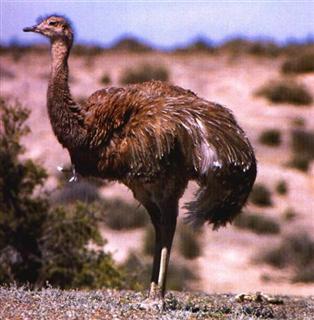Rhea
Greater Rhea Scientific Name: Rhea americana
Thu, 10th July, 2025 - 12:52 am GMT
Sponsor Ads:

Alternative Name
Greater Rhea Scientific Name: Rhea americanaBasic Info
Rheas are similar in appearance to the ostrich and are often called 'South American Ostrich.' However, unlike the ostrich, the Rhea has three toes on each foot instead of two. The Rhea stands about five feet tall and weighs about 50 pounds. Both sexes are primarily gray, with a black head, chin and neck. The feet are brownish. The Rhea has larger wings then the ostrich.
Health
Rheas are susceptible to leg problems and impaction. Chicks should be kept in brooders made of 1" chicken wire with 2' x 4' frames. The brooder should be kept at around 90 degrees. Young chicks need to be encouraged and taught to eat. Also, make sure the chicks are closed up at night to protect them. You should also be careful, when making their housing, not to have any small items, such as bolts and screws, as they will try to ingest them, The pens should be cleaned daily to ensure against disease. Older animals require grit to help them digest their food and prevent impaction. A combination of oyster shell, for calcium and crushed granite, is a good source of grit. Water should be available at all times. Rheas need plenty of room to exercise.Habitat
Low-lying plains found in the Campo region of South AmericaBehavior
The Rhea is a moderately sized ratite that originates in South America. The chicks are often raised on farms because, like the ostrich, Rheas are useful to humans for meat, hide and feathers. Rheas are social birds, congregating in flocks of up to thirty individuals. The flocks make their homes in brush-covered areas near water, as Rheas enjoy swimming. During the mating season, the male builds a nest by forming a shallow hole in the ground and filling it with dry grass. He then leads several females to the nest, where they each lay an egg in turn. This process may be completed several times and one nest can have as many as thirty eggs. The females then leave and the male incubates and cares for the chicks himself. Like other ratites, Rheas can run quite quickly but cannot fly.Origin
South AmericaHistory
Most comfortable on the low-lying plains found in the Campo region of South America, the Rhea ranges from northern and eastern Brazil to central Argentina. They can also be found in Uruguay and Paraguay. .Common Foods
In their native habitat, the Rhea is omnivorous, feeding on grass, insects and rootsSponsor Ads:
Debugging is anticipated with distaste, performed with reluctance, and bragged about forever. -- Mads Villadsen
Rhea
Coded by: BGID® | ALL RIGHTS RESERVED Copyright © 2000-2025
Disclaimer | Privacy | Report Errors / Contact | Credits








 President of the United States of America - Real Estate mogul, Pageant owner and now one of the most controversial men in political history.
President of the United States of America - Real Estate mogul, Pageant owner and now one of the most controversial men in political history.  Global warming has been in and out as the "latest" hot topic for many years. It is, according to modern scientists, the result of man-made industrial pollutants, clearing forested areas, agriculture, etc. But now they are thinking it started way before the Industrial Revolution...
Global warming has been in and out as the "latest" hot topic for many years. It is, according to modern scientists, the result of man-made industrial pollutants, clearing forested areas, agriculture, etc. But now they are thinking it started way before the Industrial Revolution...  Politician, US Vice President and President of the USA - Joseph Robinette Biden Jr.
Politician, US Vice President and President of the USA - Joseph Robinette Biden Jr.  versus
versus  Russia: 'The Evil Empire'? Are they all that bad or is it just the USA trying to portray Russia as bad because they are a world power with land bigger and a society very different from the USA ideal?
Russia: 'The Evil Empire'? Are they all that bad or is it just the USA trying to portray Russia as bad because they are a world power with land bigger and a society very different from the USA ideal? 
 Corona virus
Corona virus 
 Users with wide screen monitors can benefit from more content on every page.
Users with wide screen monitors can benefit from more content on every page.